October 13, 2006
Air Date: October 13, 2006
FULL SHOW
SEGMENTS
The Problem with Perchlorate
View the page for this story
A new study from the Centers for Disease Control suggests that long term exposure to low levels of the chemical perchlorate may be hazardous to health, especially to women of childbearing age and children. Host Steve Curwood speaks with Dr. Richard Jackson, a former director at the CDC and professor of environmental health sciences at UC Berkeley. (05:30)
Navigating Masculinity
View the page for this story
There is a growing body of scientific evidence linking men’s exposure to environmental toxins, such as cigarette smoke or herbicides, to reproductive health problems, and the health of their children. But society and the scientific world alike have been hesitant to accept the evidence, argues Cynthia Daniels in her book, "Exposing Men: The Science and Politics of Male Reproduction." Daniels is an associate professor of Political Science at Rutgers University and speaks with host Steve Curwood. (06:30)
War As an Environmental Issue
/ Jeff YoungView the page for this story
Connecticut Senator Joe Lieberman is in the fight of his political life. Lieberman has a strong record on conservation. He also supports the war in Iraq. The heated campaign battle between the senator and his opponent, Ned Lamont, has raised a tough question for environmentally-minded voters: does the war count as an environmental issue? Washington correspondent Jeff Young reports from the campaign trail. (08:00)
Tracking El Nino
View the page for this story
Another El Nino in on the way this winter, which might not be such a bad thing. Scientific evidence shows that El Nino's can have a calming effect on hurricane activity in the Atlantic. Host Steve Curwood talks with Dr. Kevin Trenberth, head of the Climate Analysis Section at the National Center for Atmospheric Research about the El Nino effects. (04:15)
No Pet Left Behind
View the page for this story
President Bush just signed legislation that requires states to have an emergency evacuation plan for pets, as well as people. Host Steve Curwood talks with Allen and Linda Anderson, authors of "Rescued: Saving Animals from Disaster" about the new animal rescue law. (04:15)
Emerging Science Note/Queries About Quasars
/ Ian GrayView the page for this story
Quasars are the brightest objects in the night sky, but they hide a dark secret...they are home to black holes. Ian Gray reports. (01:30)
Moose Milieu
/ Richard NelsonView the page for this story
Alaska conservationist Richard Nelson takes us into Denali National Park in Alaska and tells us about the majestic moose. (15:40)
This week's EarthEar selection
listen /
download
Gulls, Petrels and Kittiwakes call Great Island, off of Newfoundland, home.
Show Credits and Funders
Show Transcript
Host: Steve Curwood
Guests: Allen and Linda Anderson, Cynthia Daniels, Dr. Richard Jackson, Kevin Trenberth, Richard Nelson
Reporter: Jeff Young
Science Note: Ian Gray
[THEME]
CURWOOD: From Public Radio International - this is Living on Earth.
[THEME]
CURWOOD: I’m Steve Curwood.
The rocket fuel perchlorate is in the water supply of dozens of states. Now a study from the Centers for Disease Control suggests the pollution may have put millions of women and their children at risk of thyroid disease.
JACKSON: I was surprised. I really did not think we would find in a population that such low levels were having measurable impacts on people’s health. I think it’s a real eye-opener about what what we think are very small levels of chemicals in the environment and what they can do to us.
CURWOOD: Also, in the Connecticut Senate race war has become an environmental issue and has split the conservation community.
STEPHENSON: Every war is an environmental disaster and you can think in these kind of compartmentalized ways but it’s not a real, it’s not an honest assessment of the way the world is.
CURWOOD: Those stories and more this week on Living on Earth – stick around.
[THEME]
ANNOUNCER: Support for Living on Earth comes from the National Science Foundation and Stonyfield Farm.
[THEME]
The Problem with Perchlorate

In 2005, perchlorate was found to contaminate drinking water in 26 states, according to the EPA. (Photo Courtesy of: STI/NASA)
CURWOOD: From the Jennifer and Ted Stanley Studios in Somerville, Massachusetts - this is Living on Earth. I’m Steve Curwood. A major study by the U.S. Centers for Disease Control has concluded that trace amounts of the rocket fuel perchlorate found in drinking water, milk and produce, may be endangering the health of millions of women and their children with thyroid disease.
The CDC study, begun in 2001, looked at nearly 3,000 Americans and found health effects at quote “exposure levels unanticipated” by previous research. The findings are sure to fuel an ongoing controversy among regulators about safe levels of exposure to perchlorate, a persistent pollutant which is found in the groundwater of more than two dozen states. To find out more, we turn now to pediatrician Richard Jackson, professor of Public Health at UC Berkeley, who is a past director of the CDC’s Environmental Health Unit.
Hello Sir!
JACKSON: Hi Steve, it’s a pleasure to be with you.
CURWOOD: So doctor how surprised were you by these results?
JACKSON: I was surprised. I really did not think we would find in a population that such low levels were having measurable impacts on people’s health. I was always taught that the higher levels have the impact. This is kind of a gold standard study. You have the best laboratory in the world for doing biomonitoring looking at a robust sample of the American people and coming up with findings that have been peer reviewed extensively and I think will hold up to scrutiny anywhere.
CURWOOD: Now, Dr. Jackson, first tell me why are women the risk group here and not men? What’s different about women’s body composition that makes them a vulnerable population to something like this?
JACKSON: Well you know we all need iodine in our diet. But women in particular because of pregnancy needs and others, need some more. In fact they need to be taking vitamins when they’re pregnant. Iodine is important as an adult. It helps you make thyroid hormone. Your energy levels are related to it. But it’s particularly important to infants to the fetus for its development. In fact if a baby is born without enough iodine or thyroid hormone on board they can be left permanently damaged. So it’s really this reproductive age that we are most worried about.
CURWOOD: Now what’s the connection between perchlorate and iodine and thyroid problems in humans?
JACKSON: Well, we’ve known for a long time that we can use perchlorate to treat people with hyperactive thyroids and it will suppress thyroid’s putting out of hormones. What we didn’t know is would low doses of perchlorate suppress the thyroid’s functioning. And it looks at least from this study, and it’s just one study that, particularly in women with low iodine levels, it is having an effect on the thyroid.
CURWOOD: So how many women have relatively low iodine levels or thyroid problems?
JACKSON: We guess that about a third of the population of women ought to be getting more iodine in their diets. In fact we’ve been noticing one of the reason CDC does these studies is actually in the beginning is to profile the nutritional level of people in the United States. Over the last 30 years iodine levels in the US population have been dropping.
CURWOOD: You’re a physician, a pediatrician, for somebody who’s listening who’s concerned, particularly a women of reproductive age who’s concerned about this, what precautions might she take.
JACKSON: I think one as a public health doctor, I’m pretty passionate that tap water ought to be safe and everyone should be able to drink it. You shouldn’t have to go to bottled water and other sources. So demanding that your water suppliers are providing water within the standards and demanding the standards come into compliance with up to date science is important, number one. Number two it is important to get enough iodine in our diets. About half a teaspoon of iodized salt will give you enough to get by just fine. Thirdly, women who are pregnant need to be taking their vitamins for folic acid and lots of other and calcium and lots of other reasons as well. So those would be three things I would do.
CURWOOD: How does perchlorate end up in our ground water supply? Who’s responsible?
JACKSON: Much of the perchlorate that’s in water is a byproduct of various industrial processes. It’s quite a durable molecule. It stays in the water for long periods of time and it actually can get in to food products if that water is used for irrigation. So we’re finding perchlorate in many food products, lettuce and other vegetables that are irrigated with this water as well as finding it in the water its self.
CURWOOD: Now there’s been quite a bit of controversy over the acceptable groundwater levels of perchlorate. What do you think the impact of the CDC study on perchlorate will be?
JACKSON: One: it shows the importance of biomonitoring. When I was learning toxicology we were told well the very low doses don’t matter. It’s really the large doses that create the poisonous effect. What we’re learning from these biomonitoring studies, where large numbers of people are examined for very small levels of these chemicals and then look to see the interaction with genes or other exposures and the rest. We’re learning really kind of surprising information. I was surprised that they found such a robust finding in the CDC study at this level. As the academy of sciences sits down and weighs all this information I suspect they’re going to, if all this holds up in subsequent studies, they’re going to recommend a more stringent level. But the bottom line is it needs to be an open scientific process up front and an open management process that’s understandable once we go into setting an actual standard.
CURWOOD: Dr. Richard Jackson is a professor of environmental health sciences and the former director of the Center for Disease Control’s National Center for Environmental Health. Thank you so much Dr. Jackson.
JACKSON: My pleasure Steve, thank you.
Related link:
Centers for Disease Control Study on Perchlorate
Navigating Masculinity

Exposing Men: The Science and Politics of Male Reproduction. (Courtesy of: Oxford University Press)
CURWOOD: While much of the research on environmental hazards and reproductive health focuses on women, more and more research shows that men also run special risks.
Perhaps the most attention has been paid to men who were exposed to the defoliant Agent Orange while they were soldiers in Vietnam. Back home many of them fathered children with birth defects such as cerebral palsy and Spina Bifida. But as scientists have uncovered more evidence of the havoc toxic exposure can wreak on male reproductive health, little has been said about it. Cynthia Daniels hopes to change that. She has written a new book entitled “Exposing Men, the Science and Politics of Male Reproduction.”
Professor Daniels teaches Political Science at Rutgers University, hello.
DANIELS: Hello, thanks for having me.
CURWOOD: So, you’re a political scientist. What got you on to the subject of male reproductive health?
DANIELS: Well, in my previous work I had examined female reproductive health and female reproductive politics. Looking primarily at the criminal prosecution of women who had used drugs or alcohol during their pregnancy and then were criminally prosecuted for child abuse or delivering drugs to the fetus through the umbilical cord. In the course of doing that work I came across quite a substantial body of scientific research that indicated that men’s use of drugs and alcohol or men’s exposure to toxic substances could also produce harm in the children that they fathered. Increased rates of birth defects, increased rates of miscarriage. And so I was a little stunned by the fact that there was no public attention to this growing body of scientific evidence.

Author Cynthia R. Daniels (Photo: Katherine Daniels)
DANIELS: Well, women have historically been the property of men. So, I think we are looking at the historical vestige of the idea that we have a greater right to regulate and control the female reproductive body than the male reproductive body. And I think we still operate with this reproductive sexual division of labor where we see women as primary, it’s a cultural assumption that women have the primary responsibility for producing healthy children and caring for healthy children. And that men are really much more distant. So I think that has to do with what I see as outdated cultural assumptions about men and women’s different and disproportionate relationship to human reproduction.
CURWOOD: Perhaps as many as maybe about 15 years ago there was a lot of publicity about some research in Denmark showing that male sperm counts had dropped to, oh, maybe half of their previous levels from samples that had been taken I guess, back in the 1930’s. What was the public response to those findings and that publicity?
DANIELS: Oh, there were hundreds of newspaper stories and magazine stories about the sperm count drop. Many of them with pretty sensationalist titles like, “Sperm under Siege” and “Sperm Wars.” Many of them predicting, you know, doom and the end of the earth. It became a metaphor for what many saw as a crisis of masculinity.
CURWOOD: When these results come out the group in Denmark led by I believe it was Nils Skakkebaek and others came under tremendous attack. Why was this research group so questioned by the scientific and industrial community?
DANIELS: Well if you believe the evidence then you have to also believe that men are vulnerable to toxic harm, that men are no longer seen as the protectors of women and children, but perhaps they may even be more vulnerable to harm than women. So it undermines certain basic cultural ideals of masculinity, which I think very many people find threatening. And that, as a result, there is a great deal of both denial and panic in the public response to the evidence. I have to tell you that almost every researcher I have interviewed in relation to this book had themselves come under heavy attack every time they find positive associations between for instance male exposures to cigarette smoking for instance and increased birth defects. The response they get both from the scientific community as well as from the public at large is just, it’s just not believable. And there is still this level of denial that scientists are met with when they engage in this sort of research.
CURWOOD: So as a political scientist, where do you think we need to make changes in this society to deal with what you identify as a really serious crisis in male reproduction?
DANIELS: You know, we need to start asking the right questions. We need to start asking questions about men’s relationship to conception, to pregnancy, to childcare, child bearing. For instance the study that you had on air the other day about the association of ADHD with cigarette smoking and lead exposure. You know, I looked at that study and there were no questions asked about paternal cigarette smoking. Now how hard would it be in a study like that to ask the women not just about their own use of cigarettes but about paternal cigarette smoking. We’re not even asking the questions. Also that study indicated that there are higher rates of ADHD for baby boys, for boy children. Why then are we not asking questions about whether the male body is somehow more vulnerable to harm from lead than the female body? We seem to not even want to ask those questions.
CURWOOD: Cynthia Daniels is an associate professor of political science at Rutgers University. Her new book is called, “Exposing Men; the Science and Politics of Male Reproduction.” Thank you.
DANIELS: Thanks for having me.
Related link:
Oxford University Press
[MUSIC: Jake Shimbukura: “Spain” Gently Weeps (Hitchhike Records)]
CURWOOD: Coming up: when it’s raining cats and dogs, what to do with the cats and dogs. Stay tuned to Living on Earth.
[MUSIC: Javon Jackson: “Fun Time” Now (Palmetto)]
War As an Environmental Issue
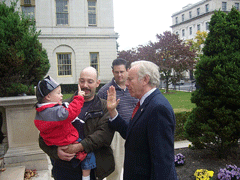
Joe Lieberman campaigning in Connecticut. (Courtesy of Lieberman 2006)
CURWOOD: It’s Living on Earth. I’m Steve Curwood.
The odd twists and turns in the race for U.S. Senate in Connecticut challenge conventional political thinking. And now it’s challenging environmental thinking as well. In the August primary, Democratic voters angry about the war in Iraq rejected Senator Joe Lieberman, who had supported the war. But in a move that divided Democrats, Joe Lieberman refused to quit. He’s running as an Independent against Democratic nominee Ned Lamont and Republican Alan Schlesinger. Joe Lieberman’s strong conservation voting record wins him support from major environmental groups, but some activists are asking why war is not considered an environmental issue.
Living on Earth’s Jeff Young reports.
YOUNG: Connecticut’s heated, hectic campaign for US Senate is nearing the home stretch. But on this sunny October afternoon Democratic nominee Ned Lamont found some time to stop and smell the flowers. He also checks out the peppers and tastes some late season tomatoes at Urban Oaks Organic Farm. The unusual farm thrives on an old brownfields site in an economically struggling section of New Britain.
LAMONT: It’s just amazing that we got an organic farm they’ll be able to open up the market within 6 months across the way.
YOUNG: Lamont is a 52-year old multimillionaire from the digital cable business who pulled off a stunning upset in August. He beat 3-term senator Joe Lieberman in the Democratic primary by focusing on the war in Iraq. Lieberman supports it, most Connecticut Democrats do not. Now Lamont needs to communicate the rest of his platform. Lamont supports a cap on carbon dioxide emissions to fight global warming, and criticizes Lieberman for a vote in favor of last year’s Energy Act, which heavily subsidized the oil and coal industries. And he stresses market solutions to environmental problems.
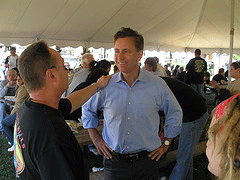
Ned Lamont on the campaign trail in October.
(Courtesy Of: Lamont Campaign)
YOUNG: If I’m the environmentally motivated voter, trying to make up my mind in this race, I might listen to you and say, ‘well, he talks a good game but what’s he actually done? You don’t really have a record to stand on, on this, do you?
LAMONT: I’d say that over the last 18 years we haven’t made real progress in the environmental movement. As I said before, we’ve got the exact same fleet mileage standards today as we had 20 years ago. CO2 and global warming are situations that are getting worse. We’re not dealing with our allies and other countries on the face of the earth in a way that says this is important to our global future. So I think you need some fresh thinking down in Washington, DC if you’re serious about the environment.
YOUNG: Lamont trails in recent polls. It’s an unusual race. The Republican, Alan Schlesinger, barely registers in polls, and that helps Lieberman. He has strong support among Republicans and is doing well among independents. And in a state where voters expect candidates to take a strong environmental stand, Lieberman has the endorsement of the League of Conservation Voters. League president Gene Karpinski gives Lieberman high scores for his votes and calls him an environmental champion.
KARPINSKI: Well it’s one thing to have a good score, which Senator Lieberman does, but it’s another to actually be someone who introduces new legislation, goes down to the floor, lobbies his or her colleagues and Joe Lieberman does all those things.
YOUNG: Lieberman pledges to continue to caucus with Democrats if reelected. But many of his environmental initiatives involve reaching out to Republicans. Three years ago when the first major piece of legislation to cap greenhouse gas emissions came to a Senate vote, it bore the names of Arizona Republican John McCain and Joe Lieberman.
LIEBERMAN: Global warming is real and America has a special responsibility as the number one emitter of greenhouse gases to do something about it.
YOUNG: Last year Lieberman again found common ground with Republicans on a bill to encourage biofuels and hybrid vehicles and reduce oil imports.

Joe Lieberman campaigning in Connecticut. (Courtesy Of: Lieberman 2006)
YOUNG: And Lieberman drew cheers from environmentalists last year for his opposition to a White House plan to drill the Arctic National Wildlife Refuge.
LIEBERMAN: We are gathered here today again to loudly and proudly defend the Alaskan wilderness form the dangerous designs of the Bush administration!
YOUNG: Despite those stands, not all environmentalists are cheering Lieberman back in Connecticut.
MOTAVALLI: Most of the environmentalists I know are probably gonna vote for Lamont.
YOUNG: Jim Motavalli edits "E the environmental magazine" at its headquarters in Norwalk, Connecticut. Motavalli is pretty plugged in to Connecticut’s environmental community. He says eco-minded voters don’t see much difference between Lamont and Lieberman on the environment. But they do see a difference on the Iraq war. And some see that as an environmental matter, as well.
MOTAVALLI: Particularly if you believe that we went to war for oil and the oil industry has one of the largest environmental impacts and if you see Lieberman’s actions as essentially protecting the American way of life vis-a`-vis oil-as-usual I think you would then have to see this as an environmental issue.
YOUNG: You don’t have to look far to find the kind of voter Motavalli’s describing.
STEPHENSON: Every war is an environmental disaster.
YOUNG: Mark Stephenson studies art at Norwalk’s community college, and until recently, he was active in the local Sierra Club chapter. Stephenson grows visibly agitated when he talks about the harm done to Iraq. And he’d prefer to see the billions spent on the war go instead to alternative energy like solar power. He and a few others pressed the local Sierra Club to consider a lawmaker’s position on the war among the environmental items when weighing political endorsements. When that idea was rejected, Stephenson quit.
STEPHENSON: Sierra Club is a wonderful organization, it does a lot of really great things but they’re missing the boat on this. Because I think ultimately people have to understand that all things are connected and you can think in these compartmentalized ways but it’s not a real, it’s not an honest assessment of the way the world is.
YOUNG: Connecticut Sierra Club leader John Blake acknowledges there was vigorous debate about the war when the chapter considered Senate candidates. Sierra’s National Political Director, Cathy Duvall, says the Club will probably not endorse a candidate in the Connecticut race. She says both Lamont and Lieberman would be good on environmental issues. As for the war, Duvall says Sierra must maintain its focus.
DUVALL: War is bad for the environment I think you can see that whether it’s happening in the current Iraq war or in any past wars. But once you start to open up that door to one set of issues around foreign policy it could open up the door to a whole bunch of other issues that also have environmental impact and it just starts to get, y’know, a little bit messier.
YOUNG: The League of Conservation Voters scores members of Congress based on what the league considers environmental votes. That does not include votes to authorize or fund the war. The League’s Gene Karpinski says he thinks that reflects what most people expect of an environmental group.
KARPINSKI: So the environment is an important issue and the war is an important issue but I think for the average person they’re seen as different issues.
YOUNG: If Connecticut’s most environmentally-minded voters do not follow the endorsement, it could indicate that national environmental group leaders are slightly out of step with rank and file members. And the debate over war as an environmental issue will likely continue well after this campaign battle is over.
For Living on Earth I’m Jeff Young in New Britain Connecticut.
Related links:
- Ned Lamont's web site on energy and environment issues.
- Joe Lieberman campaign site with statements on the environment, energy and global warming.
- League of Conservation Voters scorecard on Lieberman
- Some of the blog discussion of environmental issues in the race at the Democratic site MyDD
- "Battle Scars: Global Conflicts and Environmental Health" in The Journal of Environmental Health Perspectives
[MUSIC: Javon Jackson “In The Sticks” Now (Palmetto)]
Tracking El Nino
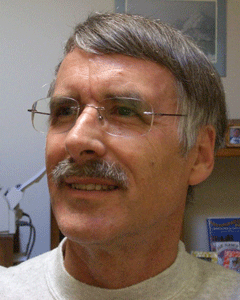
Dr. Kevin E. Trenberth is Head of the Climate Analysis Section at the National Center for Atmospheric Research. (Courtesy of The National Center for Atmospheric Research)
CURWOOD: This year’s Atlantic hurricane season won’t be over until the end of November, but compared to the triple threat fury of Katrina, Rita and Wilma in 2005, so far in the U.S. things have been tame. And, that scientists say, is due in part to the emergence of another El Niño. Usually, thanks to trade winds, the Western side of the Pacific Ocean is warmer than the East, but sometimes the warm water spreads out, changing weather patterns.
To explain this El Niño effect we turn to Kevin Trenberth, who is head of the Climate Analysis Section at the National Center for Atmospheric Research in Boulder, Colorado. Hello sir!
TRENBERTH: Hello, I’m pleased to be here.
CURWOOD: Now, how could this developing El Niño have effected our hurricane season? What did it do to hurricanes?
TRENBERTH: The developing El Niño shifts activity out into the Pacific. And that has a very large scale atmospheric circulation throughout the globe. Sort of like a very large monsoon kind of pattern that has an adverse effect on the atmospheric conditions in the Atlantic in terms of the ability to form vortices in the Atlantic. This relates to windsheer and makes it less favorable for hurricanes to form.

Dr. Kevin E. Trenberth is Head of the Climate Analysis Section at the National Center for Atmospheric Research. (Courtesy Of: The National Center for Atmospheric Research)
TRENBERTH: Well that’s what happens with the windsheer, yes. As these vortices begin to form they sort of blow apart and they can’t sustain themselves very well.
CURWOOD: Now the last major El Niño event was what, the winter of ’97-’98. And I just remember pictures of endless mudslides and rain in California and that sort of thing. How strong might it be this year and how might it be felt in the United States?
TRENBERTH: Oh, they’re certainly not predicting anything quite like that at the moment. There’s been some other El Niño events since then. There was a moderate one in 2002-2003. And this looks like at the moment more of that kind of magnitude. So it doesn’t have the global ramifications that the ‘97-’98 event was. And that’s when the name El Niño sort of came into the vernacular if you like.
CURWOOD: Come January, what are we likely to be seeing then on the national weather pattern?
TRENBERTH: In the United States in the winter time, which is when the El Niño tends to peak, it causes the storm track to shift southwards. The last example we had of this was a relatively weak El Niño in 2004-2005. The storms were barreling into Southern California and moving across the southern states and across into Florida. But that was enough to wipe out the drought in the Southwestern part of the United States. Some of those storms can then turn and barrel up the East Coast and you can end up having quite a nice snowstorm out of this in the East Coast. And meanwhile, Washington and Oregon and the far western parts of Canada are apt to be a little bit drier and sunnier.
CURWOOD: The El Niño I gather has been around for a long time, but I’m wondering if you scientists are seeing it occur more often and more intense and if so how that might be related to global climate change.
TRENBERTH: There’s certainly theoretical reasons as to why these should be related because El Niño involves moving heat around in the Pacific Ocean and global climate change involves moving heat around in the atmosphere and in the oceans and so on. So I think there’s gotta be some kind of changes. And the models do predict changes further out in the future. So this is a really serious issue especially for the Pacific Rim countries and it greatly effects the nature of climate change across the US.
CURWOOD: How?
TRENBERTH: Well what has happened in recent times is that the eastern part of the US has become wetter and cloudier and a bit, well I mentioned the increase in rainfall. And the main warming that has occurred in the US has been in the Western parts of the US and up into Alaska. Maybe this has altered perceptions about the nature of the global climate change that is going on because the Eastern US has not warmed up as much as Europe has for instance.
CURWOOD: Dr. Kevin Trenberth is head of the Climate Analysis section for the National Center for Atmospheric Research. Thank you, Sir.
TRENBERTH: You’re most welcome.
Related links:
- NOAA’s El Nino website
- The National Center for Atmospheric Research
No Pet Left Behind
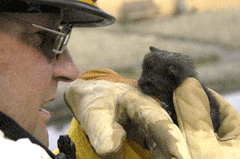
New Orleans, LA, 9-16-05 (Photo: Marvin Nauman/FEMA)
CURWOOD: After last years tragic hurricanes, President Bush said if he was ever forced to evacuate, the one thing he'd take would be his Scottish Terrier, Barney. And the president is not alone. According to a recent poll, sixty percent of Americans said they'd refuse to leave their homes if they couldn't take their pets. Well, in the future, presidents and American residents won't have to choose between evacuating and abandoning Fluffy and Fido. That’s because earlier this month George Bush signed a bill that requires officials to include pets in their disaster plans. The law ...leaving no animal left behind...is appropriately called: “PETS”: The Pets Evacuation and Transportation Standards Act. Joining me to discuss PETS are Allen and Linda Anderson, authors of the new book “Rescued; Saving Animals from Disaster”. Welcome to Living on Earth.

New Orleans, LA, 9-16-05. (Photo: Marvin Nauman/FEMA)
A. ANDERSON: Hi.
CURWOOD: This piece of legislation just flew through Congress. It passed the House and Senate virtually unanimously. Why do you suppose that was?
A. ANDERSON: Well the idea here is that people love their pets and people vote. And the President loves his dog, Barney. And as we all know from the trauma that we saw in the Gulf Coast, taking your pets with you and making sure there’s plans for evacuation-dual evacuation of people and pets during a crisis- is the only way to go in this country when pets are considered members of the family.
L. ANDERSON: Rescue a pet and you’ve rescued a family.
CURWOOD: Now specifically, what does the law do?
L. ANDERSON: What it does is it says that each state must have a disaster evacuation plan that includes pets. One of the best features of this law is that there is now money behind it. That will enable them to have pet evacuation along side human evacuation. And to set up temporary pet shelters adjacent to human shelters.
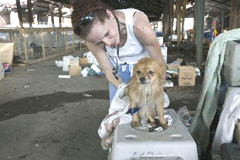
Bywater, LA., 9/18/2005 -- A Katrina volunteer dries a lost pet at a temporary animal clinic. (Photo: Andrea Booher/FEMA)
A. ANDERSON: I can see the point of view of, “I need to rescue this person and I want to bring that individual, that lady, to safety and we’re not allowed to bring her pet.” But unfortunately many of the people that were doing the rescuing weren’t going past what they considered to be the rules and maybe making exceptions in those extreme circumstances.
CURWOOD: So, with this new law then can people expect that they’ll just never have to leave their pets behind if they’re being forced to evacuate?
L. ANDERSON: In an ideal world. This is why we constantly are bringing out this message to be individually prepared. You cannot rely on any government or any entity to take care of your pets. You have to take personal responsibility.
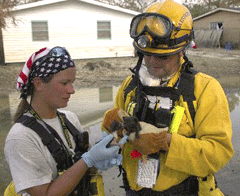
New Orleans, LA 9-16-05 -- Kathlean Baska & Roy Krueger from the "Missouri Boon County Urban Search & Rescue Task Force 1" found these kittens found while searching a house.(Photo: Marvin Nauman/FEMA)
A. ANDERSON: Do the basics: plan, prepare, and be proactive.
L. ANDERSON: You want to be able to survive for 72 hours. You want for you, your human family and your animal family, to have the food, the water, the medication. With the animals you want to have a pet evacuation kit that contains their records. You want to have a carrier for each pet. You want to have identification on the pets. It’s very good to have your animal micro-chipped.
A. ANDERSON: If your separated you need to of course have pictures in your glove compartment or anywhere on your person or so you’ll be able to identify your pet.
L. ANDERSON: Have a muzzle for your dog. That can make the difference on getting on an evacuation bus or a boat.
CURWOOD: So what happens if it comes down to a person or a pet? So six seats on the helicopter what five people and three pets?
L. ANDERSON: And one animal on your lap. We talked to people who did the most amazing things. When they had the animals on these buses and they’d finally talk a bus driver into having them on. And they’d sit there and they’d have a dog between their legs and a cat on their lap, a bird on their shoulder, what ever it took, a snake in the bag. Whatever it was that they needed. They managed to get those animals out of there.
CURWOOD: Allan and Linda Anderson’s new book is “Rescued; Saving Animals From Disaster: Life Changing Stories and Practical Suggestions.” Thank you both.
L. ANDERSON: Thank you.
A. ANDERSON: Thank you.
Related links:
- "Rescued: Saving Animals From Disaster" website
- Louisiana Society for the Prevention of Cruelty to Animals (LA/SPCA) website
- FEMA on Animal Preparedness
[MUSIC: Buckwheat Zydeco “Crying In The Street” Our News Orleans (Nonesuch)]
CURWOOD: Just ahead: moved by moose. Close encounters with Alaskan conservationist Richard Nelson. First this note on emerging science from Ian Gray.
Emerging Science Note/Queries About Quasars
[ELIZABETHAN MUSIC, MINSTREL STRUMS]
GRAY: Her eyes sparkled like diamonds in the night
Like two dancing candle flames on a tabletop
Like two of the brightest stars in the sky… [DJ scribble]
[SCIENCE NOTE MUSIC STARTS]
Forget stars…the brightest objects in the night sky are actually quasars. Shorthand for Quasi-Stellar Radio Source, quasars are astronomical engines of electromagnetic activity. They exist in the far reaches of the universe and are capable of releasing energy levels equivalent to the energy of hundreds of galaxies combined. Researchers from Ohio State University recently got a glimpse into the depths of these distant celestial bodies and found a dark secret. Quasars are home to black holes.
Normally, quasars are so far away, and their light is so intense, that astronomers can only see them in telescopes as single points of light. But this summer, a faraway galaxy came between the orbit of the earth and two quasars. The galaxy acted like a magnifying glass, boosting the power of a NASA telescope and giving astronomers the first look at the interior structure of a quasar.
Inside the quasar the scientists measured a sort of giant gravity shadow, caused by the centripetal pull of energy entering a black hole. Scientists believe that at a certain point before the energy disappears into the black hole it gives off a giant sputter that we see as the quasar.
No need to batten down the hatches yet. Luckily for us earthlings, the nearest quasar is at most, 6 billion light years away.
That’s this week’s Note on Emerging Science, I’m Ian Gray.
CURWOOD: If you enjoy listening to Living on Earth, chances are you have some pretty good ideas about things that people should hear about the environment. This could be something that’s good news, bad news or just plain interesting. And if you think it would make a worthwhile story for the radio, please get in touch. You can zap us an email at comments @ l-o-e dot org. Or call our listener line, at 800-218-9988.
It’s Living on Earth on PRI- Public Radio International.
[MUSIC: Count Ossie “Nigerian Reggae” Tales Of Mozambique (Esolden/Melodie)]
Moose Milieu
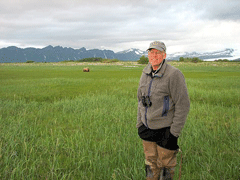
Richard Nelson in Katmai National Park.
CURWOOD: It’s Living on Earth. I’m Steve Curwood.
Today we invite you to join us on an outdoor adventure. Richard Nelson is as much at home out in the wilds of Alaska as he is in front of his hearth. He is a cultural anthropologist, conservationist, hunter and writer, and a regular on the Alaska Public Radio Network and Raven Radio in Sitka. Now, in this first installment of an occasional series "Encounters," Richard Nelson takes us to Moose country.
[MUSIC PLAYING]
NELSON: It is a beautiful, quintessentially Alaskan day. I’m in Denali National Park.
[BREATHING SOUNDS]
I am hesitating because I literally just looked off to my left, I noticed a grizzly bear. Good-sized, broad-backed, heavy-bellied, pale, tan, working its way down a mountain ridge toward me. If it keeps coming this way I am going to have to move.
I am sitting here at a much closer range to an absolutely prodigious bull moose. This is one honker of an animal. A great, dark, chocolate brown bull moose with an immense rack of antlers—you may hear a little bit of breeze,
[SOUND OF WIND BLOWING THROUGH TREES]
warm breeze, it must be 70 degrees –sitting in a batch of very, very scrubby dwarf birch, and little willows and tundra vegetation.
In this area it’s about 2,000 feet elevation and it is well above timberline so I have a view of absolutely sprawling dimensions. Looking towards the east, along the road that runs into Denali National Park, up through the valley of the Tolklat River with great, rugged, rocky-ridged mountains, all the way around. And when I turn and look the other direction, towards the West, there is the immense snowy mass of Denali—the single most enormous landform in North America, climbing high up into a pale blue sky. I am surrounded by the quintessential icons of beauty and wildness in North America. And to add one more thing, about a quarter of a mile upstream from where I am sitting right now, there is a wolf den that has eight wolves in it, two adults wolves and six pups.
Moose once kept company with the great animals of the Ice Age: the mammoths, the saber tooth tigers, huge, long-vanished animals. Moose are a survivor of that era. Moose crossed the Bering Land Bridge from Asia about 150, 000 years ago. They are the largest member of the deer family; the same family that includes white-tailed deer, black-tailed deer, mule deer, elk, caribou. Alaska has the biggest moose in the world, prime Bull Moose weigh 1,200 to 1,700 pounds. They stand up to eight feet tall. This Bull Moose that is standing so close in front of me right now, has got to be near the upper end of that. Adult female moose are pretty substantial animals too, 800 to 1300 pounds. Their color is quite variable—as I mentioned the one in front of me is a dark, a chocolaty brown—but they can go all the way from reddish brown to almost black. Their legs are a grizzled, gray-color; very long, slender legs that are good for getting around in deep winter snow, also reaching high for their brows—as this moose is doing in front of me now, he is actually waded in like an animal that is wallowing in salad—taller than this moose’s head so it is reaching up, and as it does, I can see that huge rack of antlers swaying back and forth.
Grizzly bear moving fairly quickly now towards my left, coming down into the swale, walking in that swaggering gait, a heavy, heavy gait. I’m moving a little and that’s okay, I’ve got myself in a better spot. Our big moose has now turned and he’s looking straight at me with a benign curiosity. Great dark eyes shining in the sun, and now goes back to feeding, reaching up into that tall willow it is working on.
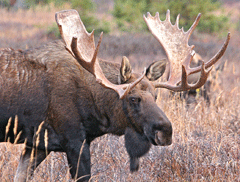
An Alaskan bull moose. (Courtesy of U.S. Fish and Wildlife Service)
Now, a look at the Alaska map shows you that this is really moose country. There’s a place called Moose Hill, there’s Moose Gulch, Moose Island, Moose Point, Moose Valley, Moose Village and Moose Pass. The dictionary of Alaska place names lists a total of seven Moose Lakes and forty-seven Moose Creeks. We need some originality I think in the naming of our creeks here!
Moose live in the great coniferous forest that sweeps all the way around the northern world, from Alaska, across all of Canada and down into some of the northern parts of the lower 48 states. Well, moose live almost everywhere in Alaska, from the mainland of the Southeast all the way up through the interior to the arctic slope. Their favorite habitat is around rivers, lakes and marshes throughout the interior and recently burned areas that are coming back with abundant willow and birch. Now this Bull Moose, near the edge of the Toklat River is well above timberline. So this moose is in a huge patch of willows and willows are very, very tall so that are well above the level of the moose’s back sometimes as he sort of swims along through this green ocean of willow. And at times all you can see is that rack of antlers moving back and forth as the moose sweeps around browsing on willow branches and willow leaves.
Moose are perhaps first and foremost an animal of winter. They seem almost impervious to the deepest winter cold. As you are traveling along by dog team or snow machine or perhaps along the road in the car, you will see them standing among the skeletal willows when it is sixty below zero, surrounded by a cloud of steam from their own breath. Their winter fur is very long and thick, and like the caribou, each hair on a moose’ s winter hide is hollow to give it excellent insulation.
The busiest time of year for moose is the fall rutting season. Bulls will rake their antlers on bushes, they strut and snort and grunt. Our bull here will eventually rake off the velvet from his antlers and he will thrash back and forth in the brush and bring those antlers to a high polish. He will then display those to other bulls and will stand broadside so another bull can see the mass of his body. They show off that way. Then they have shoving matches, pushing their antlers against each other to test their strength and establish who is dominant. They very rarely have serious battles but they often do get puncture wounds, occasionally even serious injuries, once in a while a moose will die from those battles of the mating season. Moose calves are then born about eight months later, mid-May to early-June. Cows in good moose habitat often have twins, rarely they will have triplets. That mother moose will fiercely defend her calves, never get between a cow moose and her calf. A calf moose will stay with its mother for about a year and then it gets driven away when the new calves are born— a rude separation from its mother.
Moose rarely live more than fifteen years, very few simply die of old age. Well, of course humans have been the most important predator on moose for countless thousands of years. Kenowun Indians, for example, who live in the interior of Alaska, have about fifteen words for different kinds of moose. Dineega is the general name for the animal and there are names like K'iyeedza, the biggest Bull Moose, or Deyozee, which means a cow moose. And Biditseega Hoolaanee, a cow moose with a calf or K'ik'onee Daadla, a yearling calf that that has left its mother—had that rude separation from mom. So we’ve got in front of us here K'iyeedza'—the largest bull moose.
Gwich'in people, who are neighbors just east of the Kenowun homeland are incredibly skillful moose hunters. They know all the best places to look for moose in every area and in every season. They know moose behavior so well they can predict exactly what an animal will do under almost every different kind of circumstance.
I remember being out with a Gwich'in hunter and he spotted two moose, the moose very quickly disappeared into a patch of willow. And they separated just as they disappeared. The man stopped and listened carefully, he didn’t move, and then all of a sudden he took off. I had no idea what was going on. What happened was he had heard the moose softly calling to each other. He ran towards that sound and very quickly got the one moose and then he stayed there and he kept imitating the call of the other moose. The other one came in and he got that one too. He knew that when moose separate they often circle back to find each other and call back and forth so they can locate each other, and he made use of that kind of knowledge.
Well, moose meat is the most important staple food in many interior Alaska villages and of course for many of us who live in Alaska. But also other parts of the animal are used: the hide for making warm, light weight clothing like boots. And then there’s a wonderful delicacy that you can find in many upper Alaskan communities called Moose Head Soup. You’ve got to know exactly which of the many muscles, lips, mouth tissues and bits fat to cut from the head to make this delicious delicacy.
Well by about 1900, populations of moose were severely depleted by over-hunting in most of North America. In fact, moose had become extinct in places like New England and the Great Lakes States. Then what happened is moose were protected completely from hunting, or there were strict hunting limits in areas where moose lived. Moose were also helped by re-growth of new forests after the cutting down of the old-growth forests or the burning of the forest. And then the legal protection of wetlands has also been very beneficial for moose because they like to frequent those marshy, swampy places. So moose populations—given these kinds of protections and these changes in habitat—have recovered very strongly over the past century. They are spreading back into areas where they had vanished, places like Maine, Vermont, Montana, Wyoming. They are even colonizing states where they have never been known to exist before, like Washington and Colorado. There are about one million moose in North America today. That’s as many as is estimated to exist when white settlers first arrived on this continent.
Oh my goodness! Just across the little river, about 150 yards away from me, is a black wolf moving quickly right along the edge of the willows. Probably that animal has been out all night hunting, just starting to head back home. It looks like it may have a big chunk of meat in its mouth—it’s heading back for the den.
So here now is our big bull moose, grizzly bear just up the draw, I can now see the grizzly just faintly at the edge of willows and then back behind, on the other side of the stream, the wolf. Where else in the world can you go to see all this?
Actually the moose has now come out of the willows—absolutely brilliant—against pale green vegetation, dark enormous moose, swaggering very, very casually and confidently right in the direction of that grizzly bear. I imagine that grizzly is going to have the sense to get out of the way of that moose. Oh my God, that moose is running straight towards me. It has gotten wind of the grizzly bear. Holy mackerel! Life is exciting. I’m just going to stand up here, right in the open, so that if the moose comes up on top of this ridge, it’s going to see that I’m a person and not a bear.
Where was I?
Hunters in Alaska take 6,000 to 8,000 moose each year. One adult moose can give you over 700 pounds of delicious, low fat, organic meat. You know how we tend to judge animals in Alaska not only by their beauty but by their nutritional qualities. Well moose have great economic value for Alaskans, not only as a source of food but also as a major attraction for hunters who come from all over the world. For wildlife watchers, for tourists who swarm up here from everywhere, coming from all around the world to see this wildlife, like the things that are in front of me.
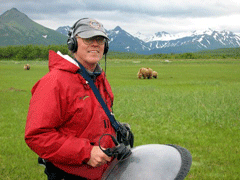
Richard Nelson recording bears in Katmai National Park (Photo: Daniel Zatz.)
CURWOOD: Nature observer Richard Nelson comes to us courtesy of Raven Radio in Sitka, Alaska. His series "Encounters" is edited by Ken Fate. To find out more about Richard Nelson or the series, go to our website at www.loe.org.
Related link:
Raven Radio
[MUSIC: Lynn Patrick “California Zephyr” Winnie’s Guitar (Little Karoo Music)]
CURWOOD: As mid-term elections near in Montana, it’s a frontier style shootout over the environment between supporters of incumbent Republican senator Conrad Burns and Democratic State Senator and organic farmer, Jon Tester. Mr. Burns is in the cross hairs for taking money from alleged polluters. His challenger is under fire for voting with quote “radicals who would cripple energy production.” High noon in Montana, this week on Living on Earth from PRI.
CURWOOD: We leave you this week – on an island in the North Atlantic Ocean.
Great Island off Newfoundland is the nesting site for a variety of seabird species.
As waves crashed against the rocks, Lang Elliott captured the calls of gulls, petrels and kittiwakes and the growls of murres.
[EARTH EAR: “Great Island Seabirds” Seabird Islands (Nature Sound Studios)]
CURWOOD: Living on Earth is produced by the World Media Foundation. Our crew includes Ashley Ahearn, Eileen Bolinsky, Bruce Gellerman, Ingrid Lobet, Emily Taylor and Jeff Young - with help from Bobby Bascomb, and Kelley Cronin. Special thanks this week to the Scott A. Nathan Charitable Trust. Our interns are Ian Gray, Tobin Hack and Jennifer Percy. Dennis Foley is our technical director. Jeff Turton engineered this week’s program. Alison Lirish Dean composed our themes. You can find us at loe dot org. I’m Steve Curwood. Thanks for listening.
ANNOUNCER: Funding for Living on Earth comes from the National Science Foundation and Stonyfield Farm. And Stonyfield farm organic yogurt, smoothies and milk. Ten percent of profits are donated to efforts that help protect and restore the earth. Details at Stonyfield dot com. Support also comes from you our listeners, the Ford Foundation, the Geraldine R. Dodge Foundation, and the Saunders Hotel Group of Boston's Lennox and Copley Square Hotels. Serving you and the environment while helping preserve the past and protect the future, 800-225-7676.
ANNOUNCER: PRI, Public Radio International
Living on Earth wants to hear from you!
Living on Earth
62 Calef Highway, Suite 212
Lee, NH 03861
Telephone: 617-287-4121
E-mail: comments@loe.org
Newsletter [Click here]
Donate to Living on Earth!
Living on Earth is an independent media program and relies entirely on contributions from listeners and institutions supporting public service. Please donate now to preserve an independent environmental voice.
NewsletterLiving on Earth offers a weekly delivery of the show's rundown to your mailbox. Sign up for our newsletter today!
 Sailors For The Sea: Be the change you want to sea.
Sailors For The Sea: Be the change you want to sea.
 The Grantham Foundation for the Protection of the Environment: Committed to protecting and improving the health of the global environment.
The Grantham Foundation for the Protection of the Environment: Committed to protecting and improving the health of the global environment.
 Contribute to Living on Earth and receive, as our gift to you, an archival print of one of Mark Seth Lender's extraordinary wildlife photographs. Follow the link to see Mark's current collection of photographs.
Contribute to Living on Earth and receive, as our gift to you, an archival print of one of Mark Seth Lender's extraordinary wildlife photographs. Follow the link to see Mark's current collection of photographs.
 Buy a signed copy of Mark Seth Lender's book Smeagull the Seagull & support Living on Earth
Buy a signed copy of Mark Seth Lender's book Smeagull the Seagull & support Living on Earth

